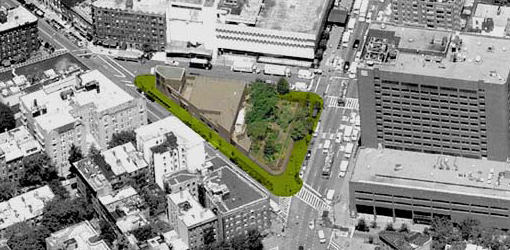Emergent Memorialization
Posted on December 16, 2011 | posted by:AIDS Memorial Park, the design competition for which was unveiled in late November, will add a much needed green space to the West Village in New York City. The park will be on a triangle of land bounded by Seventh Avenue, West 12th Street and Greenwich Avenue, across the street from the former St. Vincent hospital, which closed in the summer of 2010.
Luxury condominiums will take the place of the hospital, but the developer agreed to transform the triangle shaped site into a green space for the city. The aim of this space, beside providing a space for vegetation and wildlife, is to create a memorial to the past, present, and future struggle with the disease.
During the outbreak of the AIDS epidemic in the mid 1980s, the West Village was an entirely different place. New York City was different. Young men were dying right and left, and nobody new why; nobody wanted to discuss it. The New York Times, during the first nineteen months of the epidemic, wrote about it a total of 7 times, never mentioning it on the front page. There were more than 2300 cases.
The New York Times, during the Tylenol scare of 1982, wrote about it 54 times. There were 7 cases. New York, today a place for Pride Parades and pretty much anything else, was a different place indeed.
As I delved into this research and tried to imagine what it was like to live in this period of uncertainty, I suddenly realized my own knowledge wasn’t sufficient to even come close to proposing a memorial for this precious piece of land. As I began to research memorials and their design, I became horrified. Memorial design, it seems, has been forced to become a little bit Disney, relying on giant screens, sound installation, and dramatic fountains to lead visitors to a show-stopping catharsis that will, supposedly, heal them of their sorrows. It seems our digital, instant, and disposable culture has made, as the author Kirk Savage states in his book Monument Wars, “commemoration more about the present than the past.”
While I am not even close to submitting a proposal for the park, I know one thing for sure. If there is any way I am able to propose a memorial to something I never experienced, it must be a process contributed to by many. In fact, it must be emergent.
And so, here we go again, Steven Johnson. How can we provoke emergent solutions to problems? In his book, Emergence, Johnson describes the fascinating way ants, without any top-down design or direction, can perform monstrous tasks through the use of pheromones.
There isn’t a map, and there isn’t a plan, but somehow things get done.
If one is to propose an emergent memorial, how does one design it without actually designing it? Is it ephemeral or temporary? Does it mimic biological or ecological systems and change throughout time?
The traditional monument tends to focus on the fact of a tragedy rather than the cause; it focuses on the idea of preserving the tragedy. A tragedy, however, usually ends, and AIDS is not something that has ended. Whatever is made must somehow provide a mature, respectful, and elegant nod to the past while remembering that there is a future of people that will see this little triangle of a park as just that: a park. How can we make it meaningful for the past, the present, and the future?
More information on the AIDS Memorial Park can be found here:
http://www.architizer.com/en_us/competitions/nyc-aids-memorial-park-design-competition/
